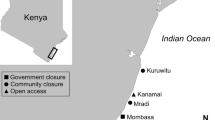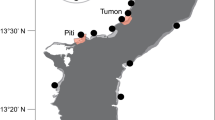Abstract
Parrotfishes can be significant bioeroders and sediment producers on coral reefs. We quantified the bioerosion rates of two similarly sized Hawaiian parrotfishes with two different feeding modes (Scarus rubroviolaceus—a scraper and Chlorurus perspicillatus—an excavator). The results showed that feeding modes did not affect bioerosion rates but that bioerosion rates were size dependent, with largest individuals (S. rubroviolaceus 45–54 cm FL) bioeroding up to 380 ± 67 kg ind−1 year−1. The size for onset of bioerosion capabilities for both species was 15 cm. Grazing by the two species consumed 60% of the carbonate production of the fore reef area, suggesting that large parrotfishes in Hawaii are ecologically important bioeroders. As individual large S. rubroviolaceus contributed disproportionately more to bioerosion and sediment production than the equivalent biomass of smaller conspecifics, management strategies designed to retain normal reef bioerosion rates should seek to preserve the historical size structure of S. rubroviolaceus populations and to especially protect the larger size classes.




Similar content being viewed by others
References
Alwany MA, Thaler E, Stachowitsch M (2009) Parrotfish bioerosion on Egyptial Red Sea reefs. J Exp Mar Biol Ecol 371:170–176. doi:10.1016/j.jembe.2009.01.019
Bellwood DR (1995a) Direct estimate of bioerosion by two parrotfish species, Chlorurus gibbus and C. sordidus, on the Great Barrier Reef, Australia. Mar Biol 121:419–429. doi:10.1007/BF00349451
Bellwood DR (1995b) Carbonate transport and within reef patterns of bioerosion and sediment release in parrotfishes (family Scaridae) on the Great Barrier Reef. Mar Ecol Prog Ser 117:127–136
Bellwood DR, Choat JH (1990) A functional analysis of grazing in parrotfishes (family Scaridae): the ecological implications. Environ Biol Fish 28:189–214. doi:10.1007/BF00751035
Bellwood DR, Hoey AS, Choat JH (2003) Limited functional redundancy in high diversity ecosystems: resilience and ecosystem function on coral reefs. Ecol Lett 6:281–285. doi:10.1046/j.1461-0248.2003.00432.x
Bellwood DR, Hughes TP, Folke C, Nystrom M (2004) Confronting the coral reef crisis. Science 429:827–833. doi:10.1038/nature02691
Brock RE (1979) An experimental study on the effects of grazing by parrotfishes and the role of refuges in benthic community structure. Mar Biol 51:381–388. doi:10.1007/BF00389216
Bruckner AW, Bruckner RJ (1998) Destruction of coral by Sparisoma viridae. Coral Reefs 17:350. doi:10.1007/s00338005013
Bruckner AW, Bruckner RJ, Sollins P (2000) Parrotfish predation on live coral: “spot” biting and “focused biting”. Coral Reefs 19:50. doi:10.1007/s003380050225
Bruggemann JH (1995) Parrotfish grazing on coral reefs: a trophic novelty. Dissertation, Rijksuniversiteit Groningen
Bruggemann JH, van Kessel AM, van Rooij JM, Breeman AM (1996) Bioerosion and sediment ingestion by the Caribbean parrotfish Scarus vetula and Sparisoma viridae: implications of fish size, feeding mode and habitat use. Mar Ecol Prog Ser 134:59–71. doi:10.3354/meps134059
Ceccarelli DM, Jones GP, McCook LJ (2005) Foragers vs. farmers: contrasting effects of two behavioural groups of herbivores on coral reefs. Oecologia 145:445–453. doi:10.1007/s00442-005-0144-y
Chazottes V, Le Campion-Alsumard T, Peyrot-Clausade M, Cuet P (2002) The effects of eutrophication-related alterations to coral reef communities on agents and rates of bioerosion (Reunion Island, Indian Ocean). Coral Reefs 21:375–390. doi:10.1007/s00338-002-0259-0
Choat JH (1991) The biology of herbivorous fishes on coral reefs. In: Sale PF (ed) The ecology of fishes on coral reefs. Academic Press, San Diego, pp 120–155
Davies PJ, Hopley D (1983) Growth facies and growth rates of Holocene reefs in the Great Barrier Reef. BMR J Aust Geol Geophys 8:237–251
Ferreira DEL, Peret AC, Coutinho R (1998) Seasonal grazing rates and food processing by tropical herbivorous fishes. J Fish Biol 53:222–235. doi:10.1111/j.1095-8649.1998.tb01029.x
Fox RJ, Bellwood DR (2007) Quantifying herbivory across a coral reef depth gradient. Mar Ecol Prog Ser 339:49–59. doi:10.3354/meps339049
Glynn PW (1997) Bioerosion and coral-reef growth: a dynamic balance. In: Birkeland C (ed) Life and death of coral reefs. Chapman & Hall, New York, pp 69–95
Grigg RW (1995) Coral reefs in an urban embayment in Hawaii: a complex case history controlled by natural and anthropogenic stress. Coral Reefs 14:253–266. doi:10.1007/BF00334349
Grigg RW (1998) Holocene coral reef accretion in Hawaii: a function of wave exposure and sea level history. Coral Reefs 17:263–272. doi:10.1007/s003380050127
Gygi RA (1975) Sparisoma viride (Bonnaterre), the stoplight parrotfish, a major sediment producer on coral reefs in Bermuda? Ecol Geol Helv 68:327–359
Harney JN, Fletcher CH (2003) A budget of carbonate framework and sediment production in Kailua Bay, Oahu, Hawaii. J Sediment Res 73:856–868. doi:10.1306/051503730856
Hawaii Cooperative Fisheries Research Unit (2008) Biology of Parrotfish in Hawaii. Final Report for the Western Pacific Regional Fishery Management Council
Hixon MA, Brostoff WN (1996) Succession and herbivory: effects of differential fish grazing on Hawaiian coral-reef algae. Ecol Monogr 66:67–90. doi:10.2307/2963481
Hooge PN, Eichenlaub WM (1997) Animal movement extension to arcview. ver. 1.1. Alaska Science Center—Biological Science Office, US Geological Survey, Anchorage, AK
Horn MH, Gibson RN (1990) Effects of temperature on the food processing of three species of seaweed-eating fishes from European coastal waters. J Fish Biol 37:237–247. doi:10.1111/j.1095-8649.1990.tb05855.x
Hubbard DK, Miller AI, Scaturo D (1990) Production and cycling of calcium carbonate in a shelf-edge reef system (St. Croix, US Virgin Islands): applications to the nature of reef systems in the fossil record. J Sediment Petrol 60:335–360
Hutchings PA (1986) Biological destruction of coral reefs. Coral Reefs 4:239–252. doi:10.1007/BF00298083
Jennings S, Lock JM (1996) Population & ecosystem effects of fishing. In: Polunin NVC, Roberts CM (eds) Tropical reef fisheries. Chapman and Hall, London, pp 193–217
Kiene WE (1989) A model of bioerosion on the Great Barrier Reef. Proc 6th Int Coral Reef Symp 3: 449–454
Law R (2000) Fishing, selection and phenotypic evolution. ICES J Mar Sci 57:659–668. doi:10.1006/jmsc.2000.0731
Lokrantz L, Nyström M, Thyresson M, Johansson C (2008) The non-linear relationship between body size and function in parrotfishes. Coral Reefs 27:967–974. doi:10.1007/s00338-008-0394-3
Manly BFJ, McDonald LL, Thomas DL (1993) Resource selection by animals: statistical design and analysis for field studies. Chapman & Hall, London
Marshall JF, Davies PJ (1982) Internal structure and Holocene evolution of One Tree Reef, southern Great Barrier Reef. Coral Reefs 1:21–29. doi:10.1007/BF00286536
Minitab (2007) http://www.minitab.com/support/docs/rel14/14helpfiles/
Mumby PJ (2006) The impact of exploiting grazers (Scaridae) on the dynamics of Caribbean coral reefs. Ecol Appl 16:747–769. doi:10.1890/1051-0761(2006)016[0747:TIOEGS]2.0.CO;2
Mumby PJ, Dahlgren CP, Harborne AR, Kappel CV, Micheli F, Brumbaugh DR, Holmes KE, Mendes JM, Broad K, Sanchirico JN, Buch K, Box S, Stoffle RW, Gill AB (2006) Fishing, trophic cascades, and the process of grazing on coral reefs. Science 311:98–101. doi:10.1126/science.1121129
Neumann AC (1966) Observations on coastal erosion in Bermuda and measurements of the boring rate of the sponge, Cliona lampa. Limnol Oceanogr 11:92–108
Ogden JC (1977) Carbonate sediment production by parrot fish and sea urchins on Caribbean reefs. Studies in geology 4: reefs and related carbonates. American Association of Petroleum Geologist, Tulsa, pp 261–279
Pari N, Peyrot-Clausade M, Hutchings PA (2002) Bioerosion of experimental substrates on high islands and atoll lagoons (French Polynesia) during 5 years of exposure. J Exp Mar Biol Ecol 276:109–127. doi:10.1016/S0022-0981(02)00243-5
Perry CT (1999) Reef framework preservation in four contrasting modern reef environments, Discovery Bay, Jamaica. J Coastal Res 15:796–812
Randall JE (2007) Reef and shore fishes of the Hawaiian Islands. Sea Grant College Program, University of Hawaii, Honolulu
Smith TB (2008) Temperature effects on herbivory for an Indo-Pacific parrotfish in Panamá: implications for coral–algal competition. Coral Reefs 27:397–405. doi:10.1007/s00338-007-0343-6
Stearn CM, Scoffin TP (1977) Carbonate budget of a fringing reef, Barbados. Proc Third Intl Coral Reef Symp v. 2: 471–477
Steneck RS (1988) Herbivory on coral reefs: a synthesis. Proc 6th Int Coral Reef Symp 1:37–49
Streelman JT, Alfaro M, Westneat MW, Bellwood DR, Karl SA (2002) Evolutionary history of parrotfishes: biogeography, ecomorphology, and comparative diversity. Evolution 56:961–971. doi:10.1554/0014-3820(2002)056[0961:EHOTPB]2.0.CO;2
Travis J (1982) A method for the statistical analysis of time-energy budgets. Ecology 63:19–25. doi:10.2307/1937026
Tribollet A, Golubic S (2005) Cross-shelf differences in the pattern and pace of bioerosion of experimental carbonate substrates exposed for 3 years on the northern Great Barrier Reef, Australia. Coral Reefs 24:422–434. doi:10.1007/s00338-005-0003-7
Tribollet A, Decherf G, Hutchings PA, Peyrot-Clausade M (2002) Large-scale spatial variability in bioerosion of experimental coral substrates on the Great Barrier Reef (Australia): importance of microbrers. Coral Reefs 21:424–432. doi:10.1007/s00338-002-0267-0
Warme JE (1976) Carbonate borers—their role in reef ecology and preservation. In: Frost SH, Weiss MP, Saunders JB (eds) Reefs and related carbonates. American Association of Petroleum Geologist, Studies in Geology, Tulsa Oklahoma no. 4:261–279
Wilkinson C (2002) Status of coral reefs of the world: 2002. Australian Institute of Marine Science, Townsville
Acknowledgments
This research was in part supported by NSF grant DGE02-32016 to K.Y. Kaneshiro. I would particularly like to thank volunteers S. Rii, J. Norris, D. Graham, members of the Holland lab and staff of the Hanauma Bay Nature Preserve for logistical support and field assistance. A. Taylor provided invaluable help with the statistical analyses. The comments of three anonymous reviewers, which substantially improved the draft, is gratefully acknowledged.
Author information
Authors and Affiliations
Corresponding author
Additional information
Communicated by D. Goulet.
Electronic supplementary material
Below is the link to the electronic supplementary material.
Rights and permissions
About this article
Cite this article
Ong, L., Holland, K.N. Bioerosion of coral reefs by two Hawaiian parrotfishes: species, size differences and fishery implications. Mar Biol 157, 1313–1323 (2010). https://doi.org/10.1007/s00227-010-1411-y
Received:
Accepted:
Published:
Issue Date:
DOI: https://doi.org/10.1007/s00227-010-1411-y




